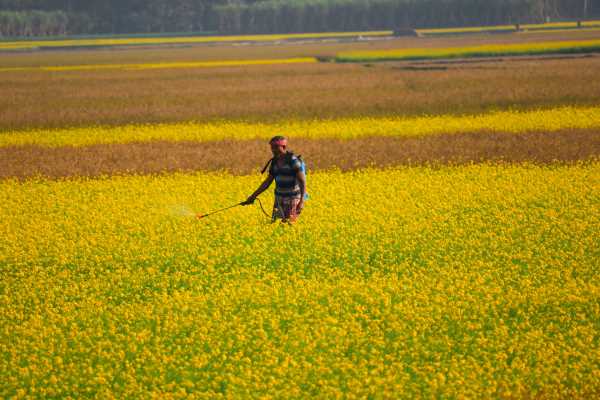Africa’s agricultural sector has long been a vital economic player and food source for feeding the continent’s growing population. Yet, in a world where the effects of climate change are rampant, the agriculture industry has become littered with unruly pests that threaten crop production and accrue catastrophic financial ruin worth billions of dollars.
Global warming has made agriculture conducive to pests, already destroying about 40% of global crops and amounting to $220 billion in losses. Currently, Africa’s annual crop losses due to insect pests are even higher than the worldwide average at 49%, driving the number of food-insecure people upward.
The world has already witnessed these impacts as 21% of Africa’s population became food insecure during the coronavirus pandemic in 2020, equating to 282 million people.
While pesticides and insecticides are standard in the agricultural sector, long-term use is highly toxic and ecologically harmful to croplands. As such, there’s an increasing demand for more affordable, sustainable, and safer alternatives for adequate pest control. In fact, recent studies indicate that an integrated pest management approach could be far more effective.
The Problem With Pesticides
Soils are some of the earth’s most biologically complex ecosystems, hosting about one-quarter of the earth’s biodiversity and being essential for crop yields. Optimal soil fertility is fuel for unique growth processes related to soil structure, nutrient cycling, carbon conversion, and pest and disease control.
However, soil fertility is lost with each application of synthetic pesticides and insecticides, as is crop growth. One study found regular pesticide applications negatively impact 70.5% of soil invertebrates and their biological services.
Additionally, pests develop a resistance to the chemical compounds that target their populations. When pesticides are continuously used in agriculture, scientists believe the insects mutate and alter their genetic makeup.
For instance, if one insect survives pesticide exposure and breeds with another insect, the offspring inherit a new genetic trait that breeds a pesticide-resistant population until chemical applications are rendered ineffective.
A 30-year-old World Health Organization (WHO) analysis found that pesticides kill about 20,000 people yearly – a study that hasn’t gone under review since. Nevertheless, the dire implications of overusing pesticides in agriculture call for a newer approach.
An Integrated Approach to Pest Control
Pesticides’ impacts on ecological damage and failing crop health are troubling for Africa’s food-insecure population, requiring more organic methods to prevent pesticide resistance and soil infertility while producing large quantities of healthy crops.
Although integrated pest management (IPM) doesn’t rid farms of pesticide use entirely, it applies as little as possible instead of relying on biocontrol methods like natural pest predation and monitoring to control unwanted insects.
In the United States, the U.S. Environmental Protection Agency (EPA) recommends following IPM’s four-tiered approach to control pests:
- Action thresholds: Determining when action is needed for pest control, such as the level of pest infestation that threatens significant crop and economic losses.
- Monitoring and identification: Accurately identifying pests and monitoring their growth to decide whether pesticides are needed.
- Prevention: Utilizing measures to prevent pest threats, such as crop rotating, planting pest-resistant crops, and companion planting.
- Control: Ongoing monitoring and identification of pests and evaluation of preventive and control measures are continuously effective.
IPM applies to commercial and residential plant growth as an environmentally sound and safe pesticide alternative. For example, U.S. homeowners may have grubs. These are shrimp-like bugs that thrive in the soil beneath the lawn and chew on roots that leave grass with unsightly brown spots. Knowing the toxic effects of pesticides on soil health and following the IPM principles can ensure you have a green, grub-free lawn for years to come.
IPM also helps reduce pollinator deaths, further boosting crop yields. A recent study found that IPM watermelon saw a 129% increase in wild bee pollination, which resulted in 26% higher yields.
Farmers in Africa can utilize new technologies to assist them with an IPM approach. For instance, a new mobile phone app called Push-Pull aims to help farmers grow potent companion plants that repel fall armyworms naturally. Upon the technique’s initial adoption, farmers reported a significant reduction in fall armyworm populations and crop yields that had either doubled or tripled.
Getting to the Root of the Problem
Pesticides have their place in agriculture. However, an integrated approach has far greater potential as an effective pest control method. The real challenge lies in helping Africa’s farmers implement IPM while ensuring they have the correct tools, crop varieties, and incentives to change their farming practices.

Jane is an agriculture and environmental journalist and the founder and editor-in-chief of Environment.co, where she covers sustainability and eco-friendly living.









[…] Source: https://farmersreviewafrica.com/finding-a-balance-between-pesticides-and-organic-pest-control-method… […]
Comments are closed.